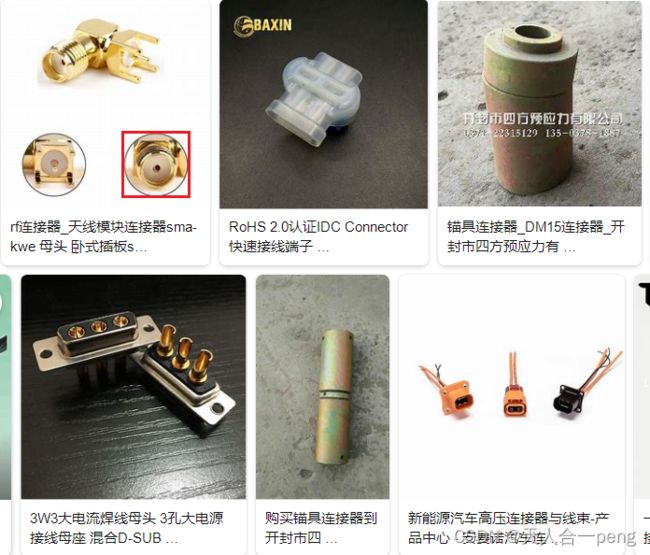通过模板匹配先定位检测的对象再检测圆形零件和孔针
先通过外面检测的大圆,以圆心定位中心孔和针的检测区域,再通过斑点检测
斑点检测时其必须为黑色,如果其检测对象是白色可通过
black_image = 255 - src_image
将检测的对象区域变为黑色
如果检测对象是黑色,则不用转化
import os
import cv2
import numpy as np
import math
import xml.etree.ElementTree as ET
import imutils
# 检测针脚位置
def needelCenter_detect(img):
params = cv2.SimpleBlobDetector_Params()
# Setup SimpleBlobDetector parameters.
# print('params')
# print(params)
# print(type(params))
# Filter by Area.
params.filterByArea = True
params.minArea = 100
params.maxArea = 10e3
params.minDistBetweenBlobs = 50
# params.filterByColor = True
params.filterByConvexity = False
# tweak these as you see fit
# Filter by Circularity
params.filterByCircularity = False
params.minCircularity = 0.2
# params.blobColor = 0
# # # Filter by Convexity
# params.filterByConvexity = True
# params.minConvexity = 0.87
# Filter by Inertia
# params.filterByInertia = True
# params.filterByInertia = False
# params.minInertiaRatio = 0.01
gray = cv2.cvtColor(img, cv2.COLOR_BGR2GRAY)
# Detect blobs.
minThreshValue = 110
_, gray = cv2.threshold(gray, minThreshValue, 255, cv2.THRESH_BINARY)
# erosion_size = 3
# # element = cv2.getStructuringElement(cv2.MORPH_ELLIPSE, (2 * erosion_size + 1, 2 * erosion_size + 1),
# # (erosion_size, erosion_size))
# element = cv2.getStructuringElement(cv2.MORPH_ERODE, (2 * erosion_size + 1, 2 * erosion_size + 1),
# (erosion_size, erosion_size))
# gray = cv2.erode(gray, element, 2)
# cv2.imshow("gray",gray)
# cv2.waitKey()
detector = cv2.SimpleBlobDetector_create(params)
gray = 255 - gray
keypoints = detector.detect(gray)
# print(len(keypoints))
# print(keypoints[0].pt[0])
# 如果这儿没检测到可能会出错
if len(keypoints) == 0:
print("没有检测到针角坐标,可能需要调整针角斑点检测参数")
return keypoints
else:
# print(len(keypoints))
# im_with_keypoints = cv2.drawKeypoints(gray, keypoints, np.array([]), (255, 0, 0),
# cv2.DRAW_MATCHES_FLAGS_DRAW_RICH_KEYPOINTS)
# if keypoints is not None:
# color_img = cv2.cvtColor(im_with_keypoints, cv2.COLOR_BGR2RGB)
# 画出圆的圆心
# cv2.circle(color_img, (int(keypoints[0].pt[0]), int(keypoints[0].pt[1])), 5, (0, 255, 0), -1)
# cv2.imshow("color_img",color_img)
# cv2.waitKey()
return keypoints
# 检测连接器圆形位置
def circle_detect(image):
# 灰度化
circle_img = image.copy()
gray = cv2.cvtColor(circle_img, cv2.COLOR_BGR2GRAY)
# minThreshValue = 150
# _, gray = cv2.threshold(gray, minThreshValue, 255, cv2.THRESH_BINARY)
# cv2.imshow("gray", gray)
# cv2.waitKey()
# print(image.shape)
# 进行中值滤波
img = cv2.medianBlur(gray, 3)
# 针角圆心坐标
out_x = 0
out_y = 0
# 霍夫变换圆检测
circles = cv2.HoughCircles(img, cv2.HOUGH_GRADIENT, 1, 10e10, param1=100, param2=30, minRadius=100, maxRadius=500)
# 如果没检测到会报错
# 这种判断方式过于简单
if circles is None:
print("没有检测到连接器外圆")
else:
for circle in circles[0]:
# 圆的基本信息
# print(circle[2])
# 坐标行列-圆心坐标
out_x = int(circle[0])
out_y = int(circle[1])
# 半径
r = int(circle[2])
# 在原图用指定颜色标记出圆的边界
cv2.circle(circle_img, (out_x, out_y), r, (0, 0, 255), 2)
# # 画出圆的圆心
cv2.circle(circle_img, (out_x, out_y), 3, (0, 0, 255), -1)
# cv2.namedWindow("circle_img", 2)
# cv2.imshow("circle_img", circle_img)
# cv2.waitKey()
# 记录外圆坐标
out_xpoint = out_x
out_ypoint = out_y
# 只框出单个针角的位置区域
step_center = 30
step_rect = 60
out_x -= step_center
out_y -= step_center
needleRect = image[out_y: out_y + step_rect, out_x: out_x + step_rect]
# cv2.namedWindow("needleRect", 2)
# cv2.imshow("needleRect", needleRect)
# cv2.waitKey()
# 根据检测到的圆形连接器中心找针角位置
centerPoint = needelCenter_detect(needleRect)
if len(centerPoint) == 0:
print("调整位置")
return False
else:
# 将针角的坐标原还至原图
in_x = int(centerPoint[0].pt[0])
in_y = int(centerPoint[0].pt[1])
in_x += out_x
in_y += out_y
# 画出针角的圆心
cv2.circle(circle_img, (in_x, in_y), 3, (0, 255, 0), -1)
# 计算两者的距离
# 假设通过标定其一个像素代表0.0056mm
DPI = 0.019696448792778324
dis = math.sqrt(math.pow(out_xpoint - in_x,2) + math.pow(out_ypoint - in_y,2))*DPI
print("两者相互之间的距离为(mm):", dis)
# 将计算结果保存在xml文件
configFile_xml = "wellConfig.xml"
tree = ET.parse(configFile_xml)
root = tree.getroot()
secondRoot = root.find("distance")
print(secondRoot.text)
secondRoot.text = str(dis)
tree.write("wellConfig.xml")
cv2.namedWindow("image", 2)
cv2.imshow("image",circle_img)
cv2.waitKey()
return True
# 1 路径写入xml文件
# 2 检测结果也写入xml
if __name__ == "__main__":
# 从xml文件中读取要检测的图片位置
configFile_xml = "wellConfig.xml"
tree = ET.parse(configFile_xml)
root = tree.getroot()
secondRoot = root.find("needleFilePath")
secondRootmatch = root.find("needleMatchFilePath")
# print(secondRoot.text)
# # 测试 如果是小图
image = cv2.imread(secondRoot.text)
template = cv2.imread(secondRootmatch.text)
#
# roi = image[1370:1680, 2200:2490]
# cv2.imwrite("temp01.jpg", roi)
#
# cv2.imshow("roi",roi)
#
# # cv2.imshow("template",template)
# cv2.waitKey()
theight, twidth = template.shape[:2]
# 执行模板匹配,采用的匹配方式cv2.TM_SQDIFF_NORMED
result = cv2.matchTemplate(image, template, cv2.TM_CCOEFF_NORMED)
# 归一化处理
cv2.normalize(result, result, 0, 1, cv2.NORM_MINMAX, -1)
# 寻找矩阵(一维数组当做向量,用Mat定义)中的最大值和最小值的匹配结果及其位置
min_val, max_val, min_loc, max_loc = cv2.minMaxLoc(result)
# 匹配值转换为字符串
# 对于cv2.TM_SQDIFF及cv2.TM_SQDIFF_NORMED方法min_val越趋近与0匹配度越好,匹配位置取min_loc
# 对于其他方法max_val越趋近于1匹配度越好,匹配位置取max_loc
strmin_val = str(max_val)
# 绘制矩形边框,将匹配区域标注出来
# min_loc:矩形定点
# (min_loc[0]+twidth,min_loc[1]+theight):矩形的宽高
# (0,0,225):矩形的边框颜色;2:矩形边框宽度
# cv2.rectangle(image, max_loc, (max_loc[0] + twidth, max_loc[1] + theight), (0, 0, 225), 2)
# 显示结果,并将匹配值显示在标题栏上
# cv2.namedWindow("MatchResult----MatchingValue=" + strmin_val, 2)
# cv2.imshow("MatchResult----MatchingValue=" + strmin_val, image)
# cv2.waitKey()
roi = image[max_loc[1]:max_loc[1] + theight, max_loc[0]:max_loc[0] + twidth]
# cv2.imshow("roi",roi)
# cv2.waitKey()
if circle_detect(roi):
print("检测成功")
else:
print("检测失败")
# # 测试1 从原图中换到连接器位置
# image = cv2.imread("SingleImages/src/single.jpg")
# # cv2.imshow("show",image)
# # cv2.waitKey()
# # 如何准确找到圆形连接器 ---》用yolo训练后能准备找到
# roi = image[1800:2300, 1800:2300 ]
# # cv2.imshow("show",roi)
# # cv2.waitKey()
# circle_detect(roi)
# # 测试2 如果是小图 需要将检测程序中的cv2.waitKey(1)修改为cv2.waitKey()不然看到图片
# image = cv2.imread("SingleImages/single04.jpg")
# # cv2.imshow("show",image)
# # cv2.waitKey()
# roi = image
# circle_detect(roi)
#
# # 测试3 检测文件夹下所有图片
# path = r"D:\BUFFER\Pycharm\ZhenJiaoDect\Images\Type02"
# for filename in os.listdir(path): # listdir的参数是文件夹的路径
# filenames = path + '\\' + filename
# # print(filenames)
# img_orig = cv2.imread(filenames, 1)
# print(filenames)
# template = cv2.imread("images/Type02/temp00.jpg")
# if img_orig is None:
# print("Warning: No Pictures")
# else:
# # 测试 如果是小图
# image = img_orig
#
#
# # roi = image[930:1310, 1658:2040]
# # cv2.imwrite("temp00.jpg", roi)
# #
# # cv2.imshow("roi",roi)
# #
# # # cv2.imshow("template",template)
# # cv2.waitKey()
#
# theight, twidth = template.shape[:2]
# # 执行模板匹配,采用的匹配方式cv2.TM_SQDIFF_NORMED
# result = cv2.matchTemplate(image, template, cv2.TM_CCOEFF_NORMED)
# # 归一化处理
# cv2.normalize(result, result, 0, 1, cv2.NORM_MINMAX, -1)
# # 寻找矩阵(一维数组当做向量,用Mat定义)中的最大值和最小值的匹配结果及其位置
# min_val, max_val, min_loc, max_loc = cv2.minMaxLoc(result)
# # 匹配值转换为字符串
# # 对于cv2.TM_SQDIFF及cv2.TM_SQDIFF_NORMED方法min_val越趋近与0匹配度越好,匹配位置取min_loc
# # 对于其他方法max_val越趋近于1匹配度越好,匹配位置取max_loc
# strmin_val = str(max_val)
# # 绘制矩形边框,将匹配区域标注出来
# # min_loc:矩形定点
# # (min_loc[0]+twidth,min_loc[1]+theight):矩形的宽高
# # (0,0,225):矩形的边框颜色;2:矩形边框宽度
# # cv2.rectangle(image, max_loc, (max_loc[0] + twidth, max_loc[1] + theight), (0, 0, 225), 2)
# # 显示结果,并将匹配值显示在标题栏上
# # cv2.namedWindow("MatchResult----MatchingValue=" + strmin_val, 2)
# # cv2.imshow("MatchResult----MatchingValue=" + strmin_val, image)
# # cv2.waitKey()
#
# roi = image[max_loc[1]:max_loc[1] + theight, max_loc[0]:max_loc[0] + twidth]
# # cv2.imshow("roi",roi)
# # cv2.waitKey()
# circle_detect(roi)
# # # 测试4 打开相机测试
# # 需要将检测程序中的cv2.waitKey()修改为cv2.waitKey(1)
# # 否则看到不视频实时检测结果
# capture = cv2.VideoCapture(0)
#
# while (True):
# # 获取一帧
# ret, frame = capture.read()
# circle_detect(frame)
#
# # cv2.imshow('frame', frame)
#
# if cv2.waitKey(1) == ord('q'):
# break
wellConfig.xml
images/OneType02/Image_04.jpg
images/NeedleTemplate.jpg
0
images/OneType03/Image_01.jpg
images/HoleTemplate.jpg
False
0.15383418280030892
https://www.baidu.com/
Good
